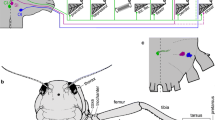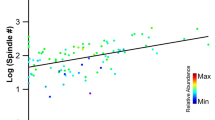Abstract
Feline caudofemoralis (CF) is a promising preparation in which to study the properties of mammalian fast-twitch skeletal muscle, but little is known about its muscle fiber properties, architecture, and motor innervation. We used histochemical techniques to confirm that it contained predominantly type IIB fibers (95±2%, n=8, with six of eight muscles composed exclusively of type IIA and IIB fibers), but physiological experiments showed less fatiguability than for the type IIB component of medial gastrocnemius. This may be related to the surprisingly strong and regular recruitment of CF during repetitive tasks such as walking and trotting, which we demonstrated electromyographically. We measured muscle length over the anatomical range of motion for CF (∼0.6–1.2 L 0) and estimated working length during walking and trotting (∼0.95–1.15 L 0). The specific tension was similar to that of the exclusively slow-twitch soleus muscle (31.2±4.7 N/cm2 compared with 31.8±4.1 N/cm2; P>0.8). Single fiber dissections of CF revealed a series-fibered architecture with a mean of 2.3 fibers, each 2.5 cm long, required to span the fascicle length. We identified two neuromuscular compartments in CF by cutting one of the two nerve branches innervating CF and depleting the glycogen stores in the intact motor units. These compartments were in parallel and extended the length of the muscle; their electromyographic activity was similar during various natural behaviors. CF and gluteus maximus motoneurons were labeled concurrently with a combination of fluorescent, retrograde tracers including Fluororuby, Fluorogold and Fast Blue. The CF motor nucleus was located in L7-S1, overlapping and intermingling extensively with the nucleus of the adjacent gluteus maximus muscle. Distributions of CF motoneuron diameter revealed one large peak around 50–55 µm, with relatively few small-diameter (less than 35 µm) cells. Using estimates of the total number of fibers in three muscles and the estimated number of α-motoneurons for those same muscles, we calculated a mean innervation ratio of ∼270, which is at the low end of the innervation ratios for type IIB motor units from other feline muscles and more similar to type IIA motor units. In general, CF appears to be a useful preparation in which to study the properties of fast-twitch muscle, but these properties may vary somewhat from type IIB fibers from different muscles.
Similar content being viewed by others
Author information
Authors and Affiliations
Additional information
Received: 22 September 1997 / Accepted: 29 December 1997
Rights and permissions
About this article
Cite this article
Brown, I., Satoda, T., Richmond, F. et al. Feline caudofemoralis muscle Muscle fibre properties, architecture, and motor innervation. Exp Brain Res 121, 76–91 (1998). https://doi.org/10.1007/s002210050439
Issue Date:
DOI: https://doi.org/10.1007/s002210050439




